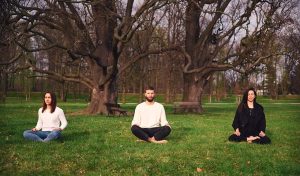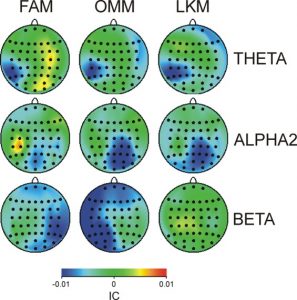Improve Attention and the Brain Systems Underlying Attention with Meditation
By John M. de Castro, Ph.D.
“the primary outcome of meditation may be to control attention and internal state in the face of the barrage of stimuli, negative and otherwise, that we experience everyday.” – Aaron D. Nitzkin
One of the primary effects of mindfulness training is an improvement in the ability to pay attention to the task at hand and ignore interfering stimuli. This is an important consequence of mindfulness training and produces improvements in thinking, reasoning, and creativity. The importance of heightened attentional ability to the individual’s ability to navigate the demands of complex modern life cannot be overstated. It helps in school, at work, in relationships, or simply driving a car. As important as attention is, it’s surprising that little is known about the mechanisms by which mindfulness improves attention
There is evidence that mindfulness training improves attention by altering the brain. It appears That mindfulness training increases the size, connectivity, and activity of areas of the brain that are involved in paying attention. A common method to study the activity of the nervous system is to measure the electrical signal at the scalp above brain regions. Changes in this activity are measurable with mindfulness training.
One method to observe attentional processing in the brain is to measure the changes in the electrical activity that occur in response to specific stimuli. These are called event-related, or evoked, potentials or ERPs. The signal following a stimulus changes over time. The fluctuations of the signal after specific periods of time are thought to measure different aspects of the nervous system’s processing of the stimulus. The P3 response in the evoked potential (ERP) is a positive going electrical response occurring between a 2.5 to 5 tenths of a second following the target stimulus presentation. The P3 component is thought to reflect attentional processing.
In today’s Research News article “Focused attention meditation training modifies neural activity and attention: longitudinal EEG data in non-meditators.” (See summary below or view the full text of the study at: https://www.ncbi.nlm.nih.gov/pmc/articles/PMC7304517/ ) Yoshida and colleagues recruited meditation-naïve college students and randomly assigned them to receive either focused meditation training or relaxation training, listening to classical music. The training occurred once a week for 30 minutes for 8 weeks. They also practiced meditation or relaxation at home for 10 minutes per day. They were measured before and after training for mindfulness. They also had brain activity measured with an electroencephalogram (EEG) before, during and after either a 5-minute meditation or relaxation and while performing an oddball task where they were asked to respond whenever a different tone the usual was presented. The evoked potentials to the tone presentations were recorded.
They found that in comparison to baseline and the relaxation group, the group that received focused meditation training had significantly faster reactions to the target stimuli during the oddball task. The evoked potentials to the oddball stimuli also demonstrated significantly larger P3 potentials in the meditation group. They also report that during meditation there was a significant increase in theta rhythm power in the EEG particularly in the frontal regions of the brain. They also found that only after 8 weeks of meditation training the greater the increase in theta power during meditation the smaller the increase in P3 magnitude during the oddball task.
These results suggest that meditation training produces an improvement in attention both behaviorally during the oddball task and also in the brain’s response to the stimuli. The results demonstrated that these changes occurred only after 8 weeks of meditation training and not after relaxation training. That mindfulness training improves attention and the P3 response in the evoked potential has been demonstrated previously.
Hence, meditation training in meditation-naïve college students improves attention both in the brain and in behavior. This improved attention should, although not investigated, produce improved performance in college academics. It remains for future research to investigate this hypothesis.
So, improve attention and the brain systems underlying attention with meditation.
“Nondirective meditation yields more marked changes in electrical brain wave activity associated with wakeful, relaxed attention, than just resting without any specific mental technique.” – ScienceDaily
CMCS – Center for Mindfulness and Contemplative Studies
This and other Contemplative Studies posts are also available on Google+ https://plus.google.com/106784388191201299496/posts and on Twitter @MindfulResearch
Study Summary
Yoshida, K., Takeda, K., Kasai, T., Makinae, S., Murakami, Y., Hasegawa, A., & Sakai, S. (2020). Focused attention meditation training modifies neural activity and attention: longitudinal EEG data in non-meditators. Social cognitive and affective neuroscience, 15(2), 215–224. https://doi.org/10.1093/scan/nsaa020
Abstract
Focused attention meditation (FAM) is a basic meditation practice that cultivates attentional control and monitoring skills. Cross-sectional studies have highlighted high cognitive performance and discriminative neural activity in experienced meditators. However, a direct relationship between neural activity changes and improvement of attention caused by meditation training remains to be elucidated. To investigate this, we conducted a longitudinal study, which evaluated the results of electroencephalography (EEG) during three-stimulus oddball task, resting state and FAM before and after 8 weeks of FAM training in non-meditators. The FAM training group (n = 17) showed significantly higher P3 amplitude during the oddball task and shorter reaction time (RT) for target stimuli compared to that of the control group (n = 20). Furthermore, a significant negative correlation between F4-Oz theta band phase synchrony index (PSI) during FAM and P3 amplitude during the oddball task and a significant positive correlation between F4-Pz theta band PSI during FAM and P3 amplitude during the oddball task were observed. In contrast, these correlations were not observed in the control group. These findings provide direct evidence of the effectiveness of FAM training and contribute to our understanding of the mechanisms underpinning the effects of meditation on brain activity and cognitive performance.
https://www.ncbi.nlm.nih.gov/pmc/articles/PMC7304517/









